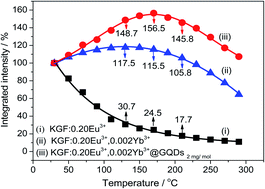Formation and enhancement of negative thermal quenching in emission of KGdF4:Eu3+, Yb3+@GQDs†
Abstract
In order to obtain a red emitting phosphor with good luminescence thermal stability, a series of KGdF4:Eu3+, Yb3+@GQD (GQD: Cl-containing graphene quantum dots) red emitting phosphors have been synthesized by the co-precipitation method, and their luminescence thermal properties have also been studied in detail. It is intriguing that the negative thermal quenching (NTQ) effect is induced by the double doping of Yb3+, and the effect is further enhanced by GQD coating. The strongest integrated PL intensities of the optimal double doped sample and the optimal GQD-coated sample are at 130 and 170 °C, in which the corresponding integrated PL intensities are presented as 117.7 and 156.5% of the initial value at 30 °C, respectively. The NTQ effect makes the optimal GQD coated sample have good luminescent thermal stability, so it can be applied for high-power WLEDs. A mechanism of energy conversion from heat to light is discussed and suggested for the effect.



 Please wait while we load your content...
Please wait while we load your content...